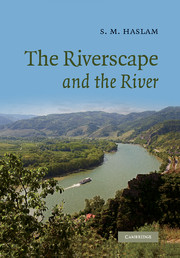Book contents
- Frontmatter
- Contents
- List of tables
- Preface
- Acknowledgements
- 1 Introduction
- 2 The natural river and its destruction
- 3 The natural riverscape and its modification
- 4 Resources I. Water resources and their loss
- 5 Development and variation of rivers
- 6 Development and variation of riverscapes
- 7 Building blocks of river vegetation
- 8 Building blocks of flood plain vegetation
- 9 Resources II. Plants and animals, cleaning and minerals
- 10 Building blocks of the riverscape
- 11 Patterns, boundaries and fragmentation
- 12 Resources III. Settlements and constructions
- 13 The harsh riverscape
- 14 The tempered or smiling riverscape
- 15 Envoi
- Bibliography
- Index to plant and animal vernacular and taxonomic names
- General subject index
10 - Building blocks of the riverscape
Published online by Cambridge University Press: 10 August 2009
- Frontmatter
- Contents
- List of tables
- Preface
- Acknowledgements
- 1 Introduction
- 2 The natural river and its destruction
- 3 The natural riverscape and its modification
- 4 Resources I. Water resources and their loss
- 5 Development and variation of rivers
- 6 Development and variation of riverscapes
- 7 Building blocks of river vegetation
- 8 Building blocks of flood plain vegetation
- 9 Resources II. Plants and animals, cleaning and minerals
- 10 Building blocks of the riverscape
- 11 Patterns, boundaries and fragmentation
- 12 Resources III. Settlements and constructions
- 13 The harsh riverscape
- 14 The tempered or smiling riverscape
- 15 Envoi
- Bibliography
- Index to plant and animal vernacular and taxonomic names
- General subject index
Summary
Culture is the hidden hand of land use planning. It marks the edges, selects the sacred and useless, and leads to place names, maps, aesthetics and ethics. There are traces of different eras, overlapping layers. The landscape is written with age-old spiritual and symbolic meaning. It is the work of ancestors, including travel, artistic, literary and historic associations.
Neutralising landscapes into building blocks of countryside will lose its symbolism, so lose the understanding that landscapes are important.
(Alümae et al., 2001)We have no idea what value future generations will place on our traditional rural landscape. But it is up to us to make it possible for our own children to husband the assets we leave behind us and to take proper care of them.
(Sporrong et al., 1995)Cultural landscapes and biodiversity should be regarded as a primary resource of development, sustainable environment and cultural tourism.
(Wildig, 2000)Introduction
The riverscape is composed of the river (or ex-river) at the bottom of the valley, the flood plain around it (if present), and the valley leading above. The pattern of the river, horizontally and vertically (Fig. 5.2) may set the pattern of the riverscape (or it may be too insignificant or the rest be too striking). Variations are huge, with topography, rock type, climate (past as well as present) and, overall, the effect of impact.
- Type
- Chapter
- Information
- The Riverscape and the River , pp. 237 - 259Publisher: Cambridge University PressPrint publication year: 2008



